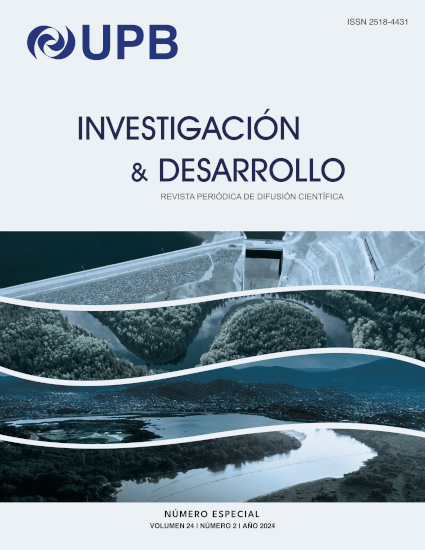ANALYSIS OF THE MORPHOLOGICAL ACTIVITY OF THE PILCOMAYO RIVER BY MEANS OF NUMERICAL MODELING
DOI:
https://doi.org/10.23881/idupbo.024.2-6iKeywords:
Morphological Modeling, Sediment Transport, Pilcomayo River, Delft3D Computational ModelAbstract
The Hydraulic Laboratory of the Universidad Mayor de San Simón in Bolivia (LHUMSS) has begun studying the morphological activity of the Pilcomayo River through the execution of physical and numerical modeling work. Numerical modeling is carried out using the Delft3D computational model. In this process, the computational model has been calibrated for the reproduction of hydrodynamic variables. The Pilcomayo River is morphologically active, with constant changes in the bed shape due to flow and high rates of suspended sediment transport. The present research work details the continuation of numerical modeling efforts on the river. The sedimentological calibration is presented, where the sediment transport observed at the Villamontes Station is reproduced, with the calibration supported by the respective statistical analysis for quantifying the residual errors between the observed and calculated values by the model, obtaining results rated as "very good" and "good" according to existing literature. Based on the calibration, the modeling of "long-term" and "short-term" morphological scenarios has been carried out, where the results show the morphological activity of the study area.Downloads
References
J. D. Brea y P. Spalletti, «Avances, retrocesos y estancamientos sobre el conocimiento de los procesos fluviales del Río Pilcomayo», en 5to Simposio Regional sobre Hidráulica de Ríos, Santiago del Estero, Argentina, 2011.
J. T. Martin-Vide, M. Amarilla, y F. J. Zárate, «Collapse of the Pilcomayo River», Geomorphology, vol. 205, pp. 155-163, 2014.
M. Heredia, M. Romero, y G. Muñoz, «Desafíos en la modelación numérica hidrodinámica de ríos morfológicamente activos: Caso de estudio del río Pilcomayo en Bolivia», en XXX Congreso Latinoamericano de Hidráulica, IAHR Publishing, 2022, ISBN 978-90-832612-4-9.
J. Molina y D. Espinoza, «Balance hídrico superficial de la Cuenca Alta del Río Pilcomayo», Informe Final, Instituto de Hidráulica e Hidrología, UMSA, La Paz, Bolivia, 2006.
INA, «Determinación de la Producción de Sedimentos por Erosión Superficial en la Cuenca Alta del Río Pilcomayo», Informe de Avance Nº1-LHA 01-628-07, Ezeiza, 2007.
J. P. Martin-Vide, S. Capape, y C. Ferrer-Boix, «Transient scour and fill. The case of the Pilcomayo River», Journal of Hydrology, vol. 576, pp. 356-369, 2019, https://doi.org/10.1016/j.jhydrol.2019.06.041.
P. Vauchel, A. Malbrunot, y R. Aguilar, «Análisis, crítica y tratamiento de los datos hidrométricos de la cuenca alta del río Pilcomayo disponibles aguas arriba de Misión La Paz (Argentina)», Proyecto Pilcomayo - SENAMHI – IRD – IHH – PV, AM, IAR, 2006.
P. Ribstein y J. Peña, «Estudio Hidrológico para la Protección contra las Inundaciones de Villamontes», Informe Técnico, 1990.
A. Malbrunot, «Sedimentology of the upper part of Pilcomayo Basin», Informe de Estudio, Proyecto de Gestión Integrada y Plan Maestro de la Cuenca del Río Pilcomayo, 2006.
G. Palenque, «Análisis de las Ecuaciones para el Transporte de la Carga de Fondo», Tesis de Grado, Universidad Mayor de San Andrés, La Paz, 1981.
EVARSA, «Análisis Granulométrico y determinación de la concentración del material en suspensión de muestras líquidas extraídas en la zona de divagación del río Pilcomayo», Informe de Resultados de Laboratorio, 2007.
N. Asselman, «Fitting and interpretation of sediment rating curves», Journal of Hydrology, vol. 234, pp. 228-241, 2000.
A. Testa Tacchino, «Caracterización hidráulica de los procesos de crecida del río Pilcomayo en la Cuenca Baja Superior», Tesis Doctoral, Universidad Nacional de Córdoba, Córdoba, Argentina, 2017.
G. R. Lesser, J. A. Roelvink, J. A. T. M. van Kester, y G. S. Stelling, «Development and validation of a three-dimensional morphological model», Coastal Engineering, vol. 51, no. 8–9, pp. 883–915, 2004.
Deltares, User Manual Delft3D-Flow, Simulation of multi-dimensional hydrodynamics flows and transport phenomena, including sediments, Delft, The Netherlands, 2022.
A. Donigian, «Calibration and Verification Issues», HSPF Training Workshop Handbook, Washington DC, 2000.
M. F. Yossef, H. R. A. Jagers, S. Van Vuren, y J. Sieben, «Innovative techniques in modelling large-scale river morphology», en River Flow 2008, Cesme, Izmir, Turkey, pp. 1065-1074, 2008.
Downloads
Additional Files
Published
Issue
Section
License
Copyright (c) 2025 Marcelo Heredia Gómez, Solange Rocha Boggero

This work is licensed under a Creative Commons Attribution-NonCommercial-ShareAlike 4.0 International License.
Creative Commons Attribution-Noncommercial-Share Alike
CC BY-NC-SA
This license lets others remix, tweak, and build upon your work for non-commercial purposes, as long as they credit the author(s) and license their new creations under the identical terms.
The authors can enter additional separate contract agreements for non-exclusive distribution of the version of the article published in the magazine (for instance, they may publish it in an institutional repository or a book), subject to an acknowledgement of its initial publication in this magazine.
